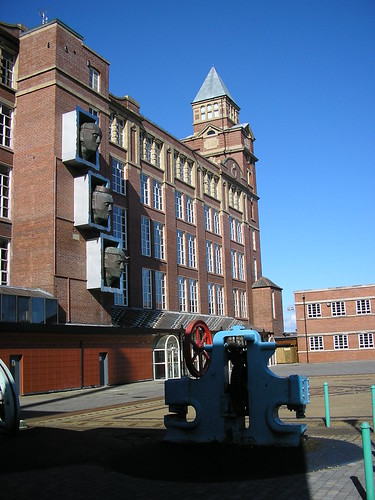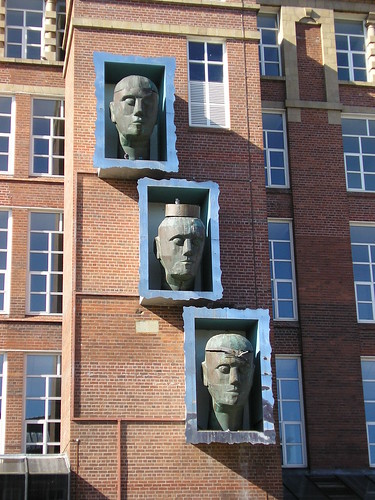
The floor of the piazza has brick paving that suggests a large rug and giant dominoes. You can make out the carpet element in the picture above.
On the wall, part of Wigan's Public Art Trail, are Andy Hazell's Three Heads. Installed in 1999, they were part of an exciting mechanical sculpture (automata). The Three heads sat on the wall above a giant mantle piece which featured symbols of the Twentieth Century and a clock. We could only see the heads - the middle one providing an ideal nesting place for a rock dove!

Wigan, in general, is closed on a Sunday so the initial walk through the urban environment wasn't as bad as it could have been. The lack of people allows you to see the part-pedestrianised streets at its best. We were confused by the instruction "Just before a dual carriageway go right down setts to St George's Church"; it was the word 'setts' that confused both Chris and I. If you are confused as well it is an old term for cobbles or Cobble Stones! Of course it is!
The River Douglas was joined near where the old Wigan Rugby League Stadium used to be (a Tesco now) Ben and Mandy may remember watching Orrell playing there some years ago.
Past an old quarry called Devil's Canyon, (That's 2 weeks we have seen property of the Devil!), now an adventure playground, we climbed up past former almshouses know as The Receptacle.
Many of the bridges on our route had cast-iron parapets. Apparently Lord Crawford of Haigh Hall made his fortune from iron and seems to have liked to use it ornamentally on the estate.
The last parts of our walk took us briefly onto the canal towpath near Haigh Hall Golf Course and then back through woodland, along an old railway track and the down the Wigan flight of locks from Rabbit Rocks back to Wigan Pier.
It is interesting that Trencherfield Mill Engine is reputedly the world's largest, original working, mill steam engine, the four-cylinder 2,500 hp giant was built and installed in its specially designed engine house at Trencherfield Mill in 1907. It’s 70 tonne flywheel enabled power to be sent throughout the vast Mill on all five floors, powering thousands of cotton spinning machines.
A very enjoyable walk and perhaps one we will revisit soon, when the bluebells are out!
Blogged with the Flock Browser
No comments:
Post a Comment